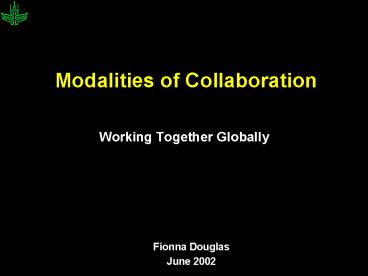Modalities of Collaboration - PowerPoint PPT Presentation
1 / 24
Title:
Modalities of Collaboration
Description:
Title: PowerPoint Presentation Author: WB74534 Last modified by: Manyong Created Date: 3/17/2001 12:13:33 AM Document presentation format: On-screen Show – PowerPoint PPT presentation
Number of Views:58
Avg rating:3.0/5.0
Title: Modalities of Collaboration
1
Modalities of Collaboration
- Working Together Globally
Fionna Douglas June 2002
2
Changing ContextsStrategic Alliances for
Impact Existing Collaboration Opportunities
3
CGIARs unique niche
- Strategic alliance for the poor
- Ensuring that knowledge remains in public domain
- Agricultural research lies at the heart of
concerns for growth, equity, social issues and
the environment
4
CGIAR Partnership
- Global alliance
- Members 22 developing and 21 industrialized
countries - Cosponsors FAO, IFAD, UNDP, World Bank
- Membership poised to grow
- 8,500 scientists and staff in more than 100
countries - 340 million budget
5
CGIAR-supported Future Harvest Centers
6
Quality Protein Maize (QPM)
- Has twice the amount of lysine, tryptophan
essential amino acids - World Food Prize 2000
- QPM planted on one million hectares, in 20
countries, boosting food, nutrition, health and
income security - In Ghana, record yields of 7 tons/ha achieved
7
Integrated Aquaculture/Agriculture (IAA)
- Aquaculture accounts for 30 of fish food
production - New Tilapia grows 60 faster, can be harvested 3
times a year - In Malawi, IAA farms produce 1.3-1.6 tons of
fish/ha (avg. lt 1 ton/ha)
8
Changing Contexts
9
Changing contexts
- Massive scientific change and exchange
- New partners, newer alliances needed
- Pace of change increasing
- Spiraling private sector investment
- Public sector remains dominant (60)
- Intellectual property rights, environmental and
social issues top development agenda - Rapid changes in operating environment (strength
of NGOs, strong NARS)
10
Growth rates, public investments in agricultural
research, 1991-96
6
5
4
3
Percentage per year
2
1
0
-
1
Developed
Sub
-
Mid
-
East
Latin
Other
China
Developing
Saharan
and North
Countries
America
Asia
countries
Africa
Africa
Source Pardey and Bientema, IFPRI, 2001
11
Public-private spending on agricultural RD,
circa 1995
Expenditures
Shares
Public
Private
Total
Public
Private
Total
(
billion
1993 international dollars
)
(
percent
)
Developing countries
11.5
0.7
12.1
94.5
5.5
100
Developed countries
10.2
10.8
21.0
48.5
51.5
100
Total
21.7
11.5
33.2
65.3
34.7
100
Source Pardey and Bientema, IFPRI, 2001
12
Emerging issues
- Knowledge divide
- Under-provision of public goods
- Social, environmental, ethical issues
- Competition for funds
- Potential of new information communication
technologies
13
Strategic Alliance for Impact
14
Rationale for CGIAR Reform
- Strengthening science and forging new alliances
- Increasing impact and relevance of CGIAR
research - Nimbler decision-making
- Designing new mechanisms to attract funds for
innovative, effective research
15
CGIAR Reforms and iSCFour Pillars
- Challenge Programs
- Executive Council
- Science Council
- System Office
16
The CGIAR System
COSPONSORS FAO, IFAD, UNDP, WB
INVESTORS Countries International
Organizations Regional Organizations Foundations
ADVISORY COMMITTEES Science Council GRPC PARTNE
RSHIP COMMITTEES NGOC PSC
CENTER COMMITTEES CBC CDC
CGIAR Secretariat
CGIAR System Office
PARTNERS Civil Society Private Sector
National Agricultural Research Institutes
Advanced Research Institutes
Future Harvest Foundation
Science Council Secretariat
Center Services
Centers CIFOR CIAT CIP CIMMYT ICARDA
ICLARM ICRAF ICRISAT IFPRI IITA ILRI
IPGRI IRRI ISNAR IWMI WARDA
CGIAR Secretariat, January 2002
17
Challenge Programs
- Time bound, high impact, independently governed
program of research - Targets CGIAR goals in relation to complex
issues of global or regional significance - Requires partnerships among a range of
institutions in order to deliver - Will generate significant outputs and impact
- Open to all stakeholders
18
Challenge Programs
- Pilot
- 3 CPs Genetic Resources, Biofortified Crops,
and Water Food to advance to full proposal
development stage - Full proposals to be ready for iSC review by July
15, 2002 - Process on website (www.cgiar.org)
19
Regular Challenge Programs
- 13 themes identified
- Call for pre proposals on themes
- An open competitive process - not restricted to
those who submitted original ideas - No funds available for preparation - but
possible for full proposal development - Deadline August 31
20
Existing Collaboration
21
Existing Collaboration
- Joint Advocacy
- Expertise contracted for analysis
- Contribution to strategy development
- Winning of competitive grants funded by World
Bank - Bank loans and grants used by countries to
contract CGIAR - CGIAR contribution to capacity building
complements national strategies
22
Opportunities
23
Opportunities
- More complete inventory and analysis
- Build on success
- Mainstream collaboration
- Achieve more visible congruence of objectives
- Ensure input at entry
- Strengthen Knowledge Management
- Strengthen linkages - increase knowledge
resource exchange
24
Opportunities
- CG Centers as hubs
- Joint projects / design / evaluation
- Increase linkage with operations
- Rapid response
- Private sector partnerships
- Extend the partnerships anchored in the common
good - Better bridge the world of high science, the
traditional wisdom of farmers, and the needs and
concerns of society































